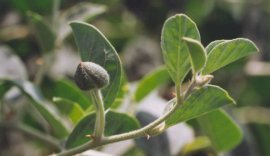The caper, which scientific name is “CAPPARIS SPINOSA”, is the floral bud of the caper bush. Its pretty flower is white with pink stamens.

The caper plant, originating from the eastern countries, is a wild plant of the “CAPPARIDECEAE” family. It grows in the Mediterranean dry and sunny areas, in an average temperature ranging from 27°C to 31°C.
This shrub with resistant trunk, whose stems are several meters long, is attached to the ground by its many and deep roots. It is a wild thorny bush and can be cultivated both in plains and in mountains. It is handmade crop and it takes place between June and August. The pollination of the caper plants is carried out mainly by bees.
| Non-pareils | 5 to 7 mm |
| Surfines | 7 to 8 mm |
| Capucines | 8 to 9 mm |
| Capotes | 9 to 11 mm |
| Fines | 11 to 13 mm |
| Gruesas | 13 to 14 mm |
| Hors-caliber | more than 14 mm |
The caliber depends on the stage of the growth at the time of the gathering. The name of each caliber can be identified according to the joined nomenclature. The smallest capers (non-pareils) are the most demanded, however, the experts will prefer medium calibers for the taste as well as the feeling in the mouth (capucines and capotes).

In order to ensure a good fermentation, the capers must be put into barrels a few hours after their gathering. It is possible thanks to our logistics of collecting and transporting fresh capers. Thus, the product keeps its freshness, its pigmented aspect, its natural color and most importantly its taste.
As soon as they arrive at the factory, the capers are carefully graded and cleaned before having their stalks removed. They are then sorted. This is all done with modern production equipment and a professional staff. Next, the capers are put into brine barrels (salt and water solution) for fermentation, and a daily monitoring guarantees the quality of the production and preserves the taste and savor that are unique to capers.
Simple processing rules, along with a good knowledge and experience of this product make our capers keep their naturally colored pigmentation and taste, and it is homogeneously and perfectly stalked.
Capers come in salt and water brine in our various barrels and standard buckets.
We pack our capers in a solution of water, salt and vinegar in all our standard bottles, tins, plastic pots and buckets. The product is then ready to be consumed.
We can also deliver our capers mixed with dry salt. Thus, they preserve better their firmness and their original taste (not mixed with the taste of vinegar). Rinsing them is enough in order to remove the visible salt and to be able to consume them. They come in drums, buckets and plastic pots.